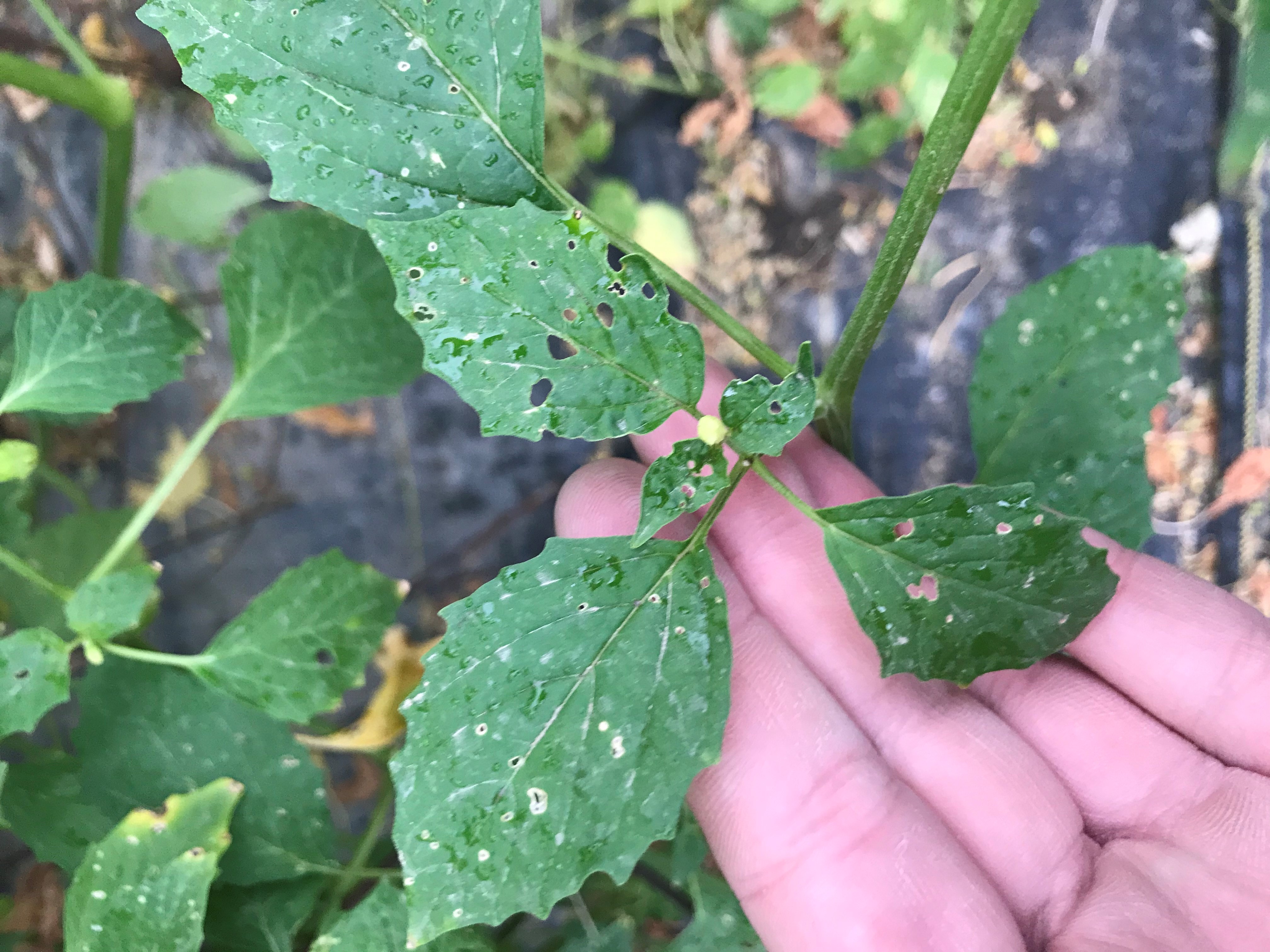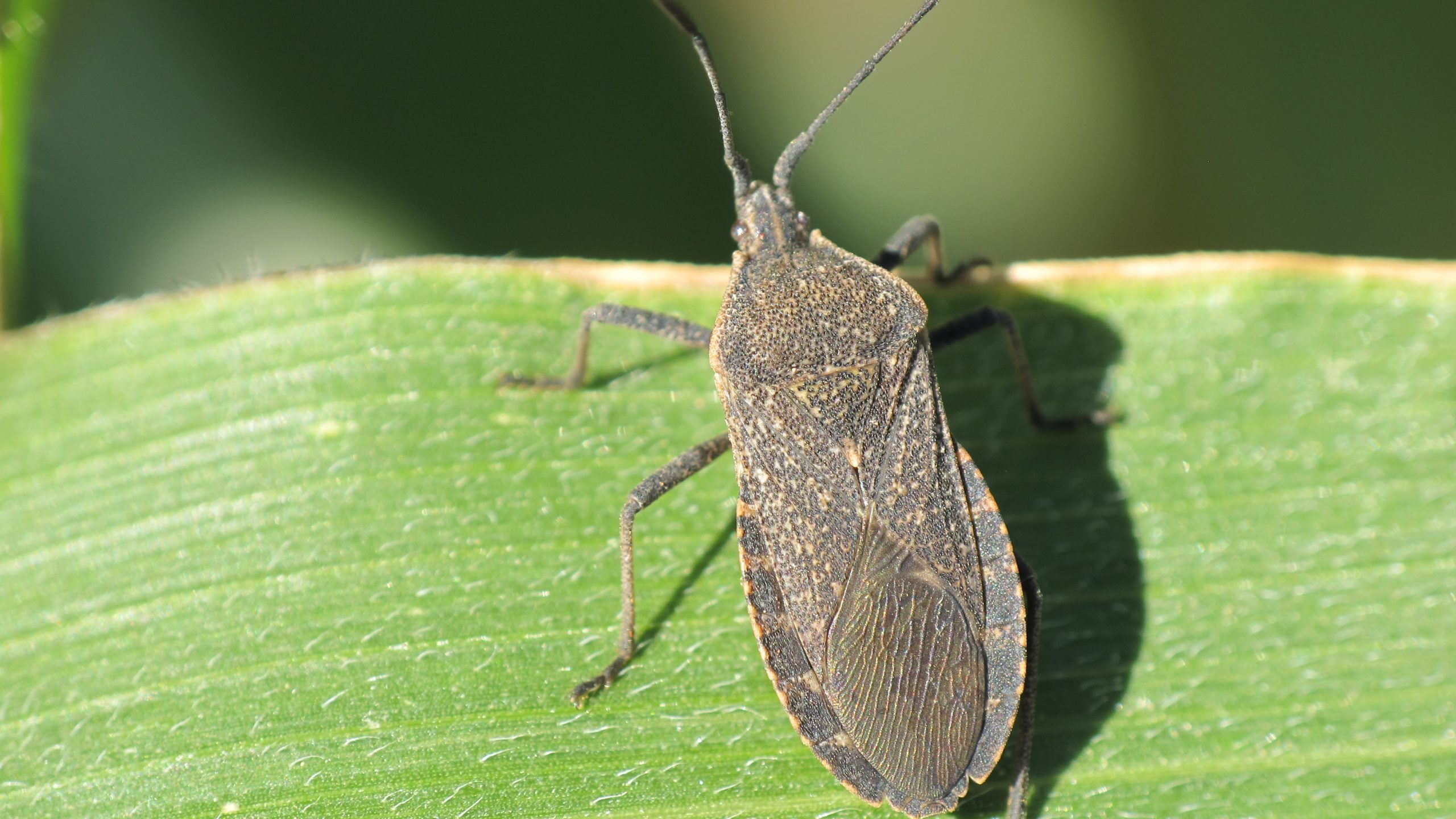Three-Lined Potato Beetle
(Lema daturaphila)
September 2020
Nick Volesky, Vegetable IPM Associate

Fig. 1. Adult stage of the three-lined potato beetle. Image courtesy of Michael J. Raupp, University of Maryland Extension.
 Fig. 2. Larval stage of the three-lined potato beetle. Image courtesy of David Cappaert, Bugwood.org.
Fig. 2. Larval stage of the three-lined potato beetle. Image courtesy of David Cappaert, Bugwood.org. Fig. 3. Egg stage of the three-lined potato beetle. Image courtesy of Michael J. Raupp, University of Maryland Extension.
Fig. 3. Egg stage of the three-lined potato beetle. Image courtesy of Michael J. Raupp, University of Maryland Extension.
Fig. 4. Microscope image of a three-lined potato beetle larva's dorsal view (left) and ventral view of chewing mouthparts (right).

Fig. 5. Tomato foliage with destructive feeding from three-lined potato beetle larvae.

Fig. 6. (Left) Adult three-lined potato beetle. (Top Right) western corn rootworm. (Center Right) striped cucumber beetle. (Bottom Right) Colorado potato beetle. Image courtesy of (left) Whitney Cranshaw, Colorado State University, Bugwood.org.
Quick Facts
- In Utah, three-lined potato beetles are pests to various crops and weeds within the nightshade family, most notably tomatillos (Physalis spp.).
- Both the adult stage and larval stage of the three-lined potato beetle are phytophagous, meaning they can cause extensive feeding damage to the foliage of host crops.
The three-lined potato beetle (Lema daturaphila) is part of the Chrysomelidae family of beetles. It originates from North and Central America but has since been reported causing economic damage to crops worldwide, such as the cape gooseberry in South Africa and potato in Australia. Though uncommon, the threelined potato beetle has previously been documented in Utah. In August 2020, it was closely observed causing economic damage in tomatillo production on a commercial vegetable farm in rural Box Elder County, Utah.
Hosts
Despite its name, the three-lined potato beetle is rarely observed on Utah potato crops. Rather, they are more prevalent in other Solanaceae crops and weeds, notably tomatillos (Physalis spp.).
Identification
Adult three-lined potato beetles are ¼ inch (7-8 mm) long and have an orange head and prothorax (segment behind head) with two black spots (Fig.1). Their femurs are orange, while the lower legs are darker. Three distinctive black stripes run lengthwise along their mustard-yellow wing coverings. Larvae are dark, greyish, and “slug-like.” They have three pairs of legs, along with a rounded black head (Fig. 2). They cover themselves with their excrement as a probable defense to being eaten. Eggs are orange, ovular and laid in clusters on foliage (Fig. 3).
Damage
Adults feed individually, while larvae tend to destroy host plants in groups. Both stages are phytophagous, meaning they create holes within leaves or cause complete defoliation (Fig. 5). This may reduce plant vigor, photosynthesis, and yield in tomatillos. Like other leaf beetles, the three-lined potato beetle evolved a physiological pathway to avoid/tolerate the lethal tropane alkaloids found in various nightshade plants.
Life Cycle
Depending on climate and region, three-lined potato beetles may overwinter in the adult stage or pupae stage in the soil. They become active again during May through August. Once emerged, they lay their eggs on the host crop’s foliage. Larvae hatch in late June or July. Larvae eventually pupate in mid to late summer, reaching the adult stage. Depending on the location and temperatures, the beetle can complete up to two generations per year, but more likely just one generation in Utah.
Management
An effective and convenient management technique for small-scale production is simply hand removing the larvae and placing them in soapy water. Other management methods include the use of insecticides. Products with effective active ingredients include permethrin and esfenvalerate. Cultural control methods can include removing nearby weeds (especially those in the nightshade family). Row covers may also be effective in excluding three-lined potato beetle adults when they emerge in the spring.
Look Alikes
A few adult insect pests appear similar to the threelined potato beetle, but are more prevalent in Utah’s vegetable production areas (Fig. 6). They include the western corn rootworm (Diabrotica virgifera), which is smaller (4-7 mm long), yellow, and has dark stripes along its back. The western corn rootworm feeds primarily on corn and cucurbits. The striped cucumber beetle (Acalymma trivittatum) is slightly larger (8-9 mm long), bright yellow, and has three black stripes. Lastly, the Colorado potato beetle (Leptinotarsa decemlineata) has a similar name and hosts; however, both the larvae and adult display key differences in shape and color.
References and Further Reading
- Monti, M. M., Ruocco, M., Grobbelaar, E., & Pedata, A. P., (2020, May 11). Morphological and Molecular Characterization of Lema bilineata (germar), a New Alien Invasive Leaf Beetle for Europe, with Notes on the Related Species Lema daturaphila Kogan & Goeden. (Insects, MDPI Publishing).
- Eaton, A.T. (2018, January 16). Three-lined potato beetle. University of New Hampshire Cooperative Extension.
- Hahn, J. (2018). Threelined potato beetles. University of Minnesota Extension.
- Raupp, M. J. (2012, June 25). Deadly Dining - Three Lined Potato Beetle, Lema Trilineata. Bug of the Week Blog. University of Maryland Extension.
- Raupp. M. J. (2015, June 16). Three-lined potato beetle larvae feeding. Bug of the Week YouTube Channel. University of Maryland Extension.
- Raupp. M. J. (2015, June 16). Colorado potato beetle larvae. Bug of the Week YouTube Channel. University of Maryland Extension.
Related Research

















